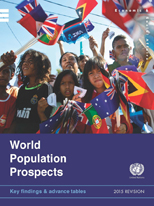DESA News
Volume 19, No.08 - August 2015
Feature articles
Breakthrough FFD3 outcome sets positive tone for global change
The world marked a momentous event in international development in Addis Ababa, Ethiopia, last month, as Governments adopted a new global framework for financing sustainable development. The Addis Ababa Action Agenda was adopted at the Third International Conference on Financing for Development (FFD3), held on 13-16 July in the Ethiopian capital. It establishes a strong foundation to support the implementation of future development efforts. Read more
World population projected to reach 9.7 billion by 2050
The current world population of 7.3 billion is expected to reach 8.5 billion by 2030, 9.7 billion in 2050 and 11.2 billion in 2100, according to the “World Population Prospects: The 2015 Revision”, launched on 29 July. “Understanding the demographic changes […], as well as the challenges and opportunities that they present for achieving sustainable development, is key to the design and implementation of the new development agenda,” said Wu Hongbo, UN DESA’s Under-Secretary-General.
Youth day puts civic engagement front and center

Youth civic engagement, a main goal of the United Nations System-Wide Action Plan on Youth, seeks to promote young people’s effective inclusive participation at all levels in society. There has been recent increasing attention and policy and programming focus on this issue by governments, UN entities, regional and multilateral organizations, CSOs, youth and researchers. This is also why the International Youth Day (IYD) celebrations will put this theme center stage this year. Read more
Global dialogue on development
- Ensuring indigenous peoples’ health and well-being
- Reflections on the Global Sustainable Development Report
- HLPF adopts declaration of commitment to ambitious people-centred post-2015 agenda
More on Global dialogue on development
Trends and analysis
- Using geospatial information to address global challenges
- Challenge calls for creative visualizations of development data
- Milestone parade to promote rights of persons with disabilities in NYC
More on Trends and analysis
Capacity development
- Supporting capacity-building efforts for effective public service delivery
- Evidence and data for gender equality
More on Capacity development
Publications and websites
Technical reports
 World Population Prospects: 2015 Revision
World Population Prospects: 2015 Revision
Published by UN DESA’s Population Division, the 2015 Revision of World Population Prospects reveals that the global population is projected to reach 9.7 billion by 2050. This latest revision represents the twenty-fourth round of official United Nations population estimates and projections. Its main results are presented in a series of Excel files displaying key demographic indicators for each development group, income group, major area, region and country for selected periods or dates within 1950-2100.
More on Publications and websites
Calendar
- Fifth Session of the UN Committee of Experts on Global Geospatial Information Management (UN-GGIM), 5-7 August, New York
- International Day of the World’s Indigenous Peoples, 10 August, New York
- International Day of Youth, 12 August, New York
All DESA calendar listings
